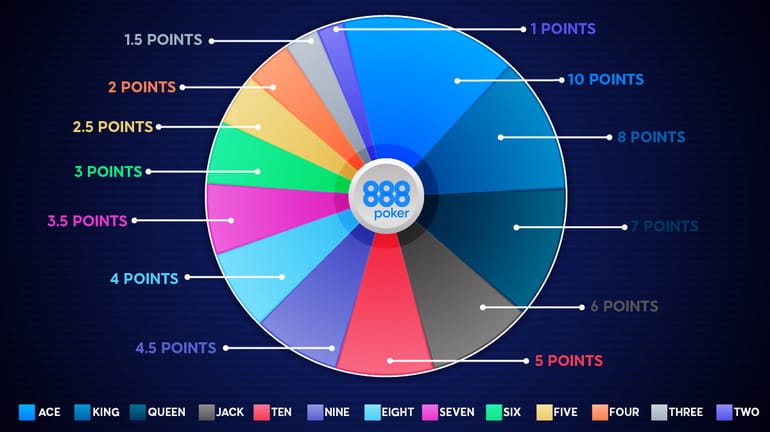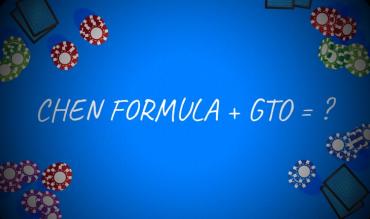The Chen Formula, named after Bill Chen, is a mathematical system for assigning a point score to various starting hands in Hold’em. The theory is that those point values can then be utilised to assist in making correct preflop decisions in No-Limit Hold’em.
In the modern poker era, it’s rare to find a professional player that still makes use of Chen’s Formula; it’s mostly considered a relic of poker history.
- But, does the system have any merits?
- How does it even work?
- How would it fare in a modern game?
Table of Contents
The Chen Formula – Usage
We begin by looking at our high card and assigning a points value:
Ace – 10 points
King – 8 points
Queen – 7 points
Jack – 6 points
Deuce through Ten – Half the value of the cards (for example, rank Seven = 3.5 points)
Of course, the strength of a hand is not defined solely by its high card. We now add some point modifiers based on the value of the second card in relation to the first.
If the cards are suited, we add two points.
If there is a gap between our two cards, we assign a points modifier based on the size of the gap.
Connected – Subtract 0 points
1 gapper – Subtract 1 point
2 gapper – Subtract 2 points
3 gapper – Subtract 4 points
4 gapper+ - Subtract 5 points.
In instances where both cards are Q-high and lower, we add 1 point for connected and 1-gap holdings. So, the net result after the previous step would be +1 for connected Q-high and lower holdings and +0 for one-gappers Q-high and lower.
The Ace is always considered high, so holdings such as A2 are 4gapper+ type hands rather than connected holdings.
At this stage, if left with a decimal score (such as 7.5), we round up to the nearest full point. 7.5 points would be counted as 8 points.
The final exception has to do with pocket pairs. Pocket pairs are worth twice their assigned points value. However, they will be worth a minimum of 5 points.
Confusing? Don’t worry. Check out the table at the end of the article for a concise guide.
The Chen Formula – Examples
Let’s take a few examples of starting hands and attempt to make use of the Chen Formula.
1) AA
2) AKo
3) JJ
4) TT
5) JTs
6) A5o
7) 5s6s
8) 72o
9) 33
10) 23o
Take a moment to work through some or all of the examples by yourself, then compare to the calculations below.:
1) An Ace is worth 10 points. We follow the pocket-pair rule of multiplying by 2 for a total score of 20 points.
2) An Ace is worth 10 points. The King is directly connected to the Ace, resulting in a 0-point subtraction. The total value of this hand is 10 points.
3) A Jack is worth 6 points. We follow the pocket-pair rule of multiplying by 2 for a total score of 12 points.
4) A Ten is worth 5 points. We follow the pocket-pair rule of multiplying by 2 for a total score of 10 points.
5) A Jack is worth 6 points. We get the suited bonus of 2 points. We add a point for holding a connector with high card Queen or lower. The total is 9 points.
6) An Ace is worth 10 points. Due to the presence of a 4-gap+, we subtract 5 points for a total score of 5 points.
7) A six is worth 3 points. We get the suited bonus of 2 points. We add an additional point for holding a connector with a high card Queen or lower. The total is 6 points.
8) A seven is worth 3.5 points. We subtract 5 points due to the presence of a 4gap+. This calculation results in a score of -1.5, which is rounded up to -1.
9) Ordinarily, a three would be worth 1.5 points. However, if we multiply this by 2, we get a score of 3 points. Pocket pairs are always worth at least 5 points. Our total score is 5 points.
10) A three is worth 1.5 points. Since we are connected, we do not need to subtract any further points. We receive the 1-point bonus for holding a connector below Queen-high. We round-up for a total score of 3 points. Note that it’s debatable whether we should include the 1-point straight bonus for this type of hand. Ideally, this hand would be worth 2 points.

Limitations of the Chen Formula
The formula provides a very reasonable idea of the value of a starting hand for new Hold’em players. It could be used to construct preflop ranges in many scenarios.
The main limitation of the Chen Formula is as follows.
The Chen Formula does not account for the precise situation.
In truth, it’s impossible to rank preflop holdings from the strongest to the weakest in poker. This fact is due to the “rock, paper, scissor” effect.
For example, which hands win in the following preflop equity matchups?
1) AKo vs 55
2) T9s vs 55
3) AKo vs T9s
1) 55 wins with 54.617% equity
2) T9s wins with 52.304% equity
3) AKo wins with 59.476% equity
So, any of these hands could be the best, depending on either our opponent’s hand or his range.
And yet, according to the Chen Formula:
1) 55 is worth 5 points.
2) T9s is worth 8 points.
3) AKo is worth 10 points.
The fact is that T9s still retains a decent chunk of its equity vs a tight range, while AKo tends to perform poorly vs very strong ranges. AKo does much better against wide ranges while T9s doesn’t get much of an equity boost in such scenarios.
For this reason, it is technically impossible to provide an accurate ranking system for preflop starting hands no matter how high the quality of the formula. This factor is not a shortcoming of the Chen Formula but rather a reflection of the complex nature of poker.
Other Ignored Variables
Ok, so the strength of a preflop holding depends heavily on the exact range our opponent shows up.
Which other essential variables are ignored by the Chen Formula?
- Stack Depth – Certain types of holdings get a boost in value as the effective stack sizes change.Mid-high pocket pairs, suited Aces, and big suited connectors tend to go up in value as the stacks get deep. Off-suit broadways, weaker pocket pairs, and weaker suited connectors tend to go down in value.
This situation is to do with the threat of larger reverse implied odds when making strong but dominated holdings. As the stacks get very deep, a hand like A5s may end up being situationally stronger than a holding such as AKo. The Chen Formula is unable to account for this.
- Multiway Action – Some hands suffer in multiway postflop scenarios while others gain a significant boost in value. Suited and connected type hands play very well multiway, while off-suit non-connected holdings don’t perform so well - even if they seem to have a lot of raw equity. Hands like AJo go down in multiway pots, while hands like 87s or A5s go up in value.
- Opponent Type – Depending on the type of Villain, we are facing,the value of different starting hands can change. Versus calling stations, we typically like to enter the pot with as much raw equity as possible. We won’t generally have great bluffing opportunities (because Villain doesn’t fold), so we want as much showdown value as possible.
Against more frequent postflop folders, we start to value more speculative holdings. We don’t need showdown value since we can bluff. Assuming our bluffs do get action, we prefer hands that can improve to strong 5-card holdings by the river, so that we can still dominate our opponents’ stronger calling range.
- Betting Structure – The Chen Formula was created at a time when limit poker was still popular and played much more frequently than it is now. Hand values change a lot between fixed-limit and no-limit betting structures, so expecting the same system to produce accurate point values for both formats is not realistic.
- Big betting structures generally favour hands that can make strong 5-card holdings by the river. In contrast, fixed-limit preflop hand selection should be weighted towards starting hands that carry more raw equity.
The Chen Formula – Quick Guide
Here is the Chen Formula in table format for easy reference:
Point values for individual cards
|
Hand Ranking |
Point Value |
|
Ace |
10 |
|
King |
8 |
|
Queen |
7 |
|
Jack |
6 |
|
Ten through Deuce |
Divide by 2 for point value |
Chen Formula System
|
Step |
Action |
|
1 – High card value |
Establish value of high card |
|
2 – Pocket pairs |
If pocket pair, multiply by 2. If lower than 5, round up to 5. |
|
3 – Connection modifier |
Subtract connection modifier. -0 for connected, -1 for 1 gap, -2 for 2gap, -4 for 3gap, otherwise -5 |
|
4 – Straight bonus |
Add +1-point straight bonus for Q-high and lower connected or 1-gapped hands. |
|
5 – Round up |
Round any half values up to the next full number |
Should I Use the Chen Formula?
On review, the Chen Formula provides an excellent starting point for learning about the strength of different starting hands in Hold’em. It can be used as a rough guide for constructing preflop ranges in common scenarios.
However, it’s important to remember that the Chen Formula has severe limitations due to the complex nature of poker itself. It’s for this reason that most poker players deviate away from using it after they become competent at adjusting to different types of preflop scenario.
Maybe we should think about the Chen Formula as training wheels on a bike. It’s an excellent way to boost initial progress. But once we can ride, we no longer need those extra wheels.


